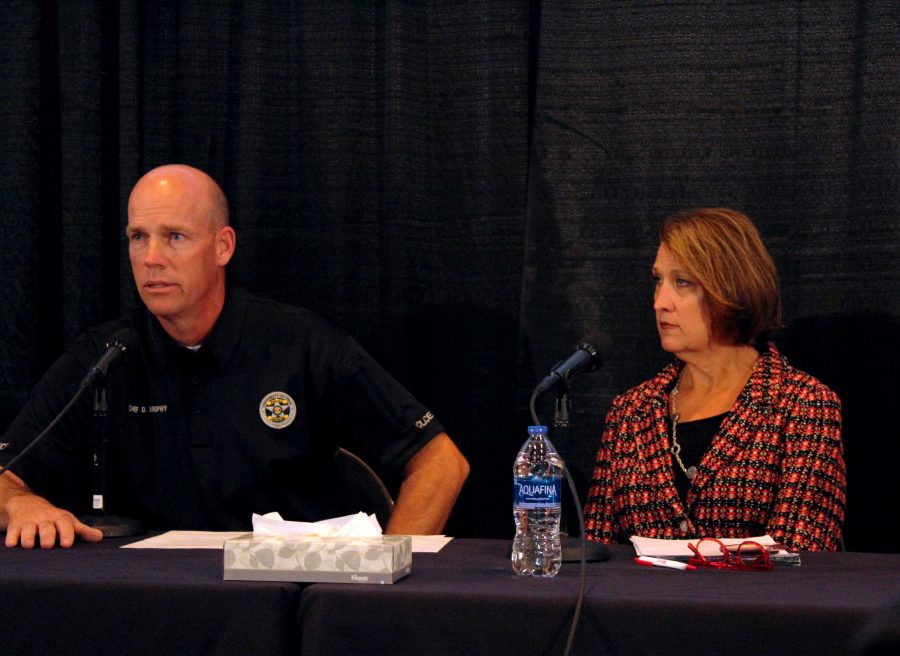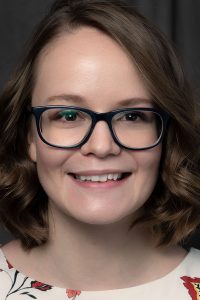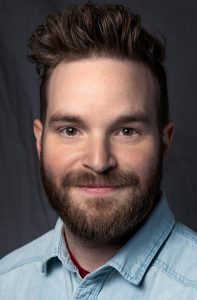Warning: This story contains graphic descriptions of violence.
University of Utah President Ruth Watkins announced Thursday the school is initiating an independent investigation into the actions taken by the university police department (UPD) following the reports of harassment Lauren McCluskey made leading up to her death. It will also hire an outside agency to review the school’s policies relating to campus safety.
Watkins and university police Chief Dale Brophy said they have met with McCluskey’s family multiple times since the shooting to discuss the details of the case. Prior to the press conference, Watkins presented McCluskey’s parents with a posthumous bachelor’s degree in communication. The 21-year-old was a track athlete who ranked 10th all-time at the school in pentathlon.
McCluskey’s death has received international attention. On Wednesday, schools throughout Utah called on their students to wear red to honor her memory. Hundreds attended a vigil that evening mourning her loss.
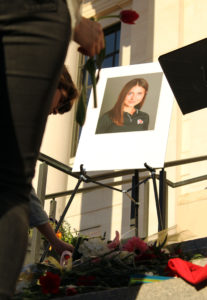
Earlier on Thursday, Utah Gov. Gary Herbert ordered an investigation into the actions of the Utah Department of Corrections and Board of Pardons and Parole to determine if any mistakes were made in the supervision of McCluskey’s killer, Melvin Rowland.
The U’s campus was placed on lock-down Monday after police found McCluskey shot and killed in the backseat of a car. Her parents had called UPD to report a suspected kidnapping. According to a statement McCluskey’s mother, Jill, posted to Twitter on Tuesday, McCluskey had previously dated Rowland for approximately one month. She ended the relationship after she discovered he had lied about his name, age and criminal background.
Rowland was a convicted felon and registered sex offender, stemming from offenses in 2004. After entering prison, he was released on parole twice before he most recently left custody on April 17. Each time, Rowland was rearrested for parole violations.
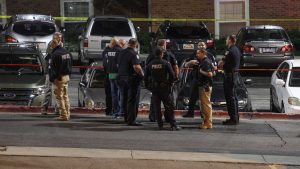
“Rowland was a manipulator,” Brophy said. “If his lips were moving, I believe he was lying.”
Brophy said he welcomes the investigation and that the review will focus on the department’s procedures — not the actions of individual officers.
“We’re committed to doing what we need to do to make sure that everything on this campus is as safe as possible,” he told reporters. “The question is — do we have the appropriate protocols in place to prevent an event like this from happening?”
“Trying to be as complete as possible,” Brophy went through a timeline of the events leading up to McCluskey’s death.
April 17
Rowland was granted parole and released directly into the community, according to the Utah Department of Correction’s Public Information Officer Kaitlin Felsted. This is a correction to information university officials provided to the press on Tuesday.
Sept. 2
McCluskey met Rowland for the first time at a local bar where he was working as security for a company called Black Diamond Security Group, which the Utah Department of Commerce issued a cease and desist order against Thursday for unlicensed activity. The 37-year-old told her he was 30 years old and did not disclose his criminal history or status as a sex offender. The two “immediately” began a relationship, according to Brophy. Rowland frequently visited her dormitory and made friends with other students living there.
Oct. 9
McCluskey learned Rowland’s identity, including his age and sex offender status, through a friend, according to her mother. She asked him to come to her residence hall and confronted him. He admitted to being a sex offender, but continued to insist he was 30 years old. McCluskey broke off the relationship, but allowed Rowland to spend the night. The next day, she lent him her car to run errands.
Oct. 10
McCluskey’s mother contacted campus police and requested an escort to help Lauren retrieve her car from Rowland. When police reached out to McCluskey, she initially declined an escort, telling them Rowland planned to drop the car off at her dorm and that she was comfortable with this plan. Police told Lauren security officers would be nearby in case she needed help, and asked her to call back in that event. She did call back later, letting campus police know Rowland had left her car at Rice-Eccles Stadium instead. She needed a ride to pick up the car, which a security escort subsequently provided.
Oct. 12
McCluskey reported suspicious texts she was receiving to campus police. She believed they were sent by Rowland’s friends. The texts said Rowland was dead and blamed her for the death. McCluskey checked social media, saw activity on Rowland’s accounts, and determined that Rowland was alive.
Despite the messages, McCluskey reported not feeling in any danger. She did, however, feel that Rowland’s friends were trying to “lure her somewhere,” Brophy said. The officer with whom she was speaking instructed McCluskey not to go anywhere she was uncomfortable and to call again if she got any more strange messages.
Oct. 13
McCluskey called university police again, reporting more messages. The senders were attempting to blackmail her, threatening to post intimate images of herself and Rowland online unless she paid them. McCluskey felt these messages were either from Rowland himself or from some of his friends. They arrived from multiple phone numbers. She sent $1,000 to an account before contacting police.
A detective was assigned who began building a case for potential sexual extortion charges.
At this point, police knew Rowland was a registered sex offender but did not reach out to Adult Probation & Parole for more information about him. As a result, the department was unaware of his status as a parolee who should have been jailed for violating the terms of that parole. They felt there wasn’t enough evidence of Rowland’s connection to the criminal activity to share the behavior with other law enforcement agencies. The department’s process, as it currently stands, requires detectives to gather evidence and then make contact directly with a suspect. Only at this point would they have contacted Adult Probation & Parole.
The department also did not help McCluskey seek a restraining order. She reported feeling safe and there was no indication to police that Rowland posed a physical threat to her.
Oct. 16
Six days before the shooting was the last time the state Department of Corrections had contact with Rowland.
Oct. 19
University police began the formal investigation into the suspicious messages McCluskey had received. Brophy explained that, in the days since the report, officers were working on other cases that needed urgent attention. Once the case was active, a detective reached out to McCluskey to obtain more information. The plan was to identify all suspects and seek an arrest warrant for the people involved, whether that was Rowland or his friends.
Oct. 19 – 22
Security video shows Rowland at various campus locations.
Oct. 22, 10:39 a.m.
McCluskey emailed police, saying she received a text message from someone claiming to be Deputy Chief Rick McLenon. The text asked that she come to the police station. Police now believe this message was sent by Rowland in an attempt to get her to leave her dorm room.
Oct. 22, 3 p.m. – 6 p.m.
Rowland waited for Lauren in the residence hall with some of her friends.
Oct. 22, 8:20 p.m.
McCluskey was walking through the parking lot outside of the South Medical Tower at the U, talking to her mother on the phone. Rowland approached her and an altercation ensued. She dropped all of her belongings, including her cell phone — the call with her mother was still active. Rowland dragged her to a different area in the parking lot, forced her into the backseat of a car he had driven to campus and shot her multiple times.
Rowland was a felon and, as a result, could not legally obtain a gun. He had borrowed the firearm from an acquaintance earlier, claiming he wanted to teach his girlfriend to shoot. This friend reached out to police himself and is cooperating with the investigation. According to the timeline provided by university officials, “It is not anticipated that any charges will be filed.” However, Brophy said that decision is ultimately up to the district attorney.
Oct. 22, 8:23 p.m.
McCluskey’s father, Matthew McCluskey, called campus police saying he felt his daughter was in danger. He told police that her mother heard Lauren said, “No, no, no!” on the phone and there was nothing afterward.
Oct. 22, 8:32 p.m.
An officer who had knowledge of the case was working at the time McCluskey’s parents called. He knew who McCluskey was and where she lived, so he helped direct officers to the area. When they reached the parking lot, police located McCluskey’s belongings and searched her dorm room trying to determine if she made it home, according to Brophy. More officers were called.
Oct. 22, 8:38 p.m.
Rowland was picked up in a silver Hyundai, which left campus. Police saw this on surveillance video. He had called a women he met just days earlier on a dating website and told her he needed a ride after finishing a workout on campus. The two went to dinner at a local restaurant, visited the state Capitol building and went to her home in downtown Salt Lake City. Rowland showered there. Later, she dropped him off at a coffee shop. Brophy said police will not name the restaurant or the coffee shop, but that there is surveillance footage of his movements.
Later, this woman saw news coverage of the shooting which included Rowland’s photo and called police. Like the friend who allowed Rowland to borrow a gun, she is cooperating with police and they do not believe she will face charges.
Oct. 22, 9:55 p.m.
Officers searching the parking lot outside the South Medical Tower at the U found McCluskey’s body. Less than a minute later, campus was placed on lock-down via an emergency alert sent to students, staff and faculty. It stated there had been a shooting on campus.
Oct. 22, 10:09 p.m.
A campus alert which included a description of Rowland was sent. Jill McCluskey had mentioned him to police as a potential suspect.
Oct. 22, 11:46 p.m.
University police discovered Rowland had left campus and lifted the secure-in-place order, feeling it was unlikely Rowland would return to campus. As Brophy explained, people who have committed crimes almost always want to distance themselves from the scene of the crime as quickly as possible.
Oct. 23, 12:01 a.m.
A campus alert was sent which identified Melvin Rowland as the suspect in McCluskey’s shooting, although her identity and the fact of her death had not yet been released.
Oct. 23, 12:46 a.m.
The Salt Lake City Police Department located Rowland in downtown Salt Lake City. He was on foot on 600 S. A chase ensued and he entered Trinity A.M.E. Church at 239 E. 600 S. through the back door. When police followed him into the building, they heard a commotion followed by a gunshot in the upstairs of the church. Police found Rowland dead by self-inflicted gunshot wound.
Oct. 23, 1:47 a.m.
The university sent a campus alert saying Rowland had been located and was no longer a threat.
Watkins said the agencies that the U will contract to conduct the investigation and review into police and campus safety have not yet been determined. A campus safety task force first assembled in 2016 by former President David Pershing to address issues of sexual assault. That task force will reconvene with the oversight of the independent contractor. The university does not yet have a timeline for either action, but Watkins said it will commence as soon as possible.
“I want you to know that I have great confidence in the diligent work of the University Police Department, of Chief Brophy and of our officers,” Watkins said. “We have not uncovered mistakes. We do want, together — both of us are committed to an independent review to learn what we can and stay committed to campus safety for everyone at the University of Utah.”


